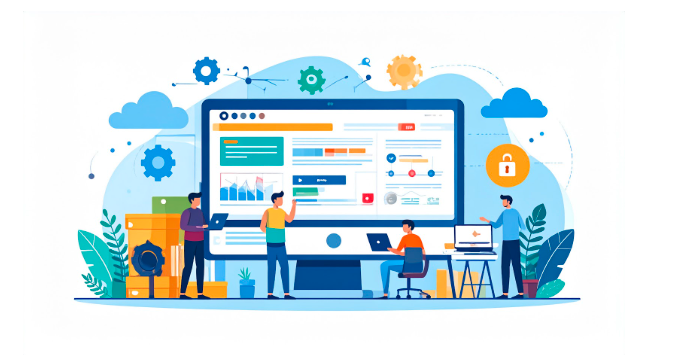Launching a SaaS project in today’s environment is simultaneously easier and more challenging than ever before. Easier, because founders and product teams now operate within an unprecedented ecosystem of frameworks, APIs, and cloud platforms that can reduce months of work into weeks. Harder, because the abundance of available choices — frontend frameworks, backend stacks, deployment pipelines, payment systems, and hosting solutions — can overwhelm even experienced developers.
This article provides a detailed roadmap for those navigating the SaaS development journey. It explores what truly matters, when to leverage ready-made solutions, and when to invest in custom development. The insights presented here reflect years of professional web development practice, where modern full-stack setups have been refined through practical implementation in real SaaS environments. The article has been prepared based on materials from the web development company Kavita Systems.
The modern SaaS technology stack often looks like this:
- Design & Frontend: Figma, Vue, Nuxt, Inertia.js, TailwindCSS, Shadcn UI, PrimeVue, Pinia, Vite
- Backend: Laravel, Node.js, PHP (with Twill & Statamic for CMS features)
- Databases & Caching: PostgreSQL, MySQL, Redis, Memcached
- API Layer: REST, GraphQL, OpenAI API integrations
- DevOps & CI/CD: Docker, GitHub Actions, Bitbucket Pipelines, Turborepo, BigQuery, Ubuntu/Linux
- Cloud & Infra: Cloudflare, Google Cloud, Vercel, Supabase, Firebase
This type of stack has been tested and refined by professional web development teams, where both startups and enterprises rely on strong technology foundations combined with pragmatic, business-driven decision-making. It also illustrates the core of what we deliver through our Web Application Development Services: from design and frontend engineering to backend architecture, integrations, cloud infrastructure, and ongoing product growth.
More about Laravel Development Services: https://kavitasystems.com/our-services/laravel-development-company
Part 1. What Really Matters in SaaS Web Development
When most people discuss SaaS development, they quickly dive into technical frameworks or cloud providers. Yet the deeper truth is that technology should serve strategy — not the other way around. The following non-negotiables form the backbone of every successful SaaS project:
- Clarity of Purpose
A SaaS product must solve a clearly defined problem. If a founder or team cannot articulate the primary job of the product in one concise sentence, the choice of framework becomes irrelevant. - Simplicity First
Overengineering is one of the most common early mistakes. Many SaaS companies have scaled to thousands of customers while running monolithic applications before ever considering microservices. - Performance & Accessibility
Users demand fast loading, responsive layouts, and accessible interfaces. Stacks combining Vue with Nuxt or Inertia.js, styled with TailwindCSS, often provide the right balance of speed, developer efficiency, and long-term scalability. - Security by Default
Authentication, API access, and data integrity should be treated as core product features rather than afterthoughts. - Observability & Feedback Loops
Robust logging, analytics, and monitoring show how systems behave in production, while structured user feedback ensures teams are solving the right problems.
Part 2. Ready-Made vs. Custom Development: Finding the Balance
The SaaS ecosystem is overflowing with ready-made tools: Stripe for billing, Supabase for authentication, Firebase for real-time data, Cloudflare for CDN and security. These services accelerate early development but introduce trade-offs.
- Advantages: Speed, reliability, lower maintenance overhead.
- Disadvantages: Vendor lock-in, reduced flexibility, and potential pricing challenges at scale.
Custom code, meanwhile, is where differentiation emerges. No SaaS product succeeds because it reinvents login pages; it succeeds because it offers unique workflows, analytics, or experiences that cannot be replicated by competitors.
Practical Rule:
- Use ready-made services for infrastructure such as authentication, payments, and hosting.
- Reserve custom code for the areas where your SaaS delivers its true value.
Part 3. Frontend: From Figma to Production
Design in Figma
Every SaaS journey begins with design. Modern teams rely on Figma to craft design systems, build reusable components, and collaborate with stakeholders. Plugins allow direct export of design tokens into code, keeping designers and developers synchronized.
Vue, Nuxt, and Inertia.js
- Vue is an excellent foundation for building modern SaaS interfaces.
- Nuxt adds SSR, static generation, and robust routing for projects that require separation of frontend and backend.
- Inertia.js provides a pragmatic alternative by enabling Vue components within Laravel projects, effectively creating a modern monolith with server-side rendering support.
Styling with TailwindCSS, Shadcn UI, and PrimeVue
- TailwindCSS: Highly flexible styling without CSS bloat.
- Shadcn UI: Headless components built on Radix primitives.
- PrimeVue: A wide library of ready components, often used in unstyled mode and extended with Tailwind for custom branding.
State Management & DX
- Pinia: Lightweight, modular, and TypeScript-friendly state management.
- Vite: Delivers instant hot reloads and optimized builds, dramatically improving developer experience.
Part 4. Backend Foundations
Laravel and Node.js
- Laravel excels in building robust business logic quickly, supported by packages like Cashier (billing) and Jetstream (authentication).
- Node.js shines in real-time APIs, websocket servers, and background processing.
CMS Integrations
When SaaS platforms require content management (blogs, help centers, landing pages), Twill and Statamic provide seamless Laravel integration.
API Strategy
Core workflows — billing, reporting, data imports — should be built as APIs. REST and GraphQL extend reach to web clients, mobile apps, and integrations. Increasingly, SaaS platforms enrich user experience with OpenAI APIs, delivering AI-powered features such as intelligent search or automated content.
Part 5. Databases and Caching
- PostgreSQL: The default for most SaaS platforms due to its reliability, performance, and support for semi-structured data.
- MySQL: Still relevant for straightforward transactional needs.
- Redis & Memcached: Essential for caching, sessions, and real-time features.
Schema design should account for multi-tenancy, whether by row-level tenant IDs or schema-per-tenant strategies.
Part 6. DevOps, CI/CD, and Data Pipelines
Smooth operations are critical for any SaaS project, and achieving them requires a carefully designed approach to infrastructure and automation. Docker plays a central role by providing consistent environments across development, staging, and production. For continuous integration and deployment, teams often rely on services like GitHub Actions or Bitbucket Pipelines, which ensure that testing, building, and releasing new features happen in a streamlined and automated way. When projects involve both frontend and backend code, along with shared libraries, Turborepo becomes invaluable for managing monorepos efficiently. At the data level, BigQuery supports robust pipelines for analytics and business intelligence dashboards, enabling teams to draw meaningful insights from product usage. All of this typically runs on a foundation of Ubuntu or other Linux-based systems, which provide a stable and proven environment for SaaS applications.
To be effective, every deployment pipeline should not only handle builds and deployments but also incorporate linting and testing as integral steps. Ideally, it should generate preview environments for each pull request, giving teams the ability to validate changes in realistic conditions before merging them into production.
Part 7. Cloud & Infrastructure
Hybrid cloud architectures often combine:
- Cloudflare for CDN, caching, and DDoS protection.
- Google Cloud for enterprise infrastructure and AI APIs.
- Vercel for frontend deployments with serverless functions.
- Supabase for PostgreSQL-as-a-service with authentication.
- Firebase for real-time databases and push notifications.
This modular approach helps keep costs low during early stages while maintaining scalability for global growth.
Part 8. SaaS Launch Roadmap
- 0–2 Weeks: Define & Scaffold
Design core flows in Figma. Scaffold Vue/Nuxt or Inertia.js frontend and Laravel backend. Configure authentication and billing. - 3–6 Weeks: MVP Build
Develop the primary feature set, workspace creation, subscription flows, and initial analytics. - 7–10 Weeks: Private Beta
Invite early adopters, integrate monitoring, and gather structured feedback. - Beyond 10 Weeks: Iteration & Scale
Expand features, refine user experience, and scale infrastructure only as actual demand requires.
Part 9. Common Pitfalls
One of the recurring mistakes in early-stage SaaS development is the temptation to overengineer from the very beginning. Teams often dive headfirst into microservices or Kubernetes-based architectures before they have a real need for such complexity, burning time and resources on infrastructure that does not yet contribute to product-market fit. Another common issue lies in the onboarding experience. Even if the technology is solid, a SaaS platform without a clear and intuitive onboarding flow will struggle to retain users. People need to understand the value of the product within minutes, otherwise they churn and rarely return.
Founders also sometimes fall into the trap of reinventing the wheel when it comes to critical but commoditized features like billing or authentication. Solutions such as Stripe or Supabase already provide secure, scalable, and thoroughly tested systems, whereas custom-built alternatives often become a source of technical debt and security risks.
Finally, the importance of reliable backups is too often underestimated. A single incident of data loss can destroy user trust and permanently damage a product’s reputation, regardless of how innovative or well-designed the rest of the system might be.
Conclusion: The SaaS Launch Formula
Launching a SaaS product is not about chasing the trendiest stack but about achieving balance:
- Move quickly with ready-made infrastructure.
- Invest in custom code only where it creates unique value.
- Maintain simplicity until scale demands complexity.
- Continuously measure, iterate, and respond to user feedback.
With modern stacks that combine Figma, Vue, Nuxt, Inertia.js, Laravel, Node.js, PostgreSQL, Redis, Docker, Cloudflare, and Google Cloud, a SaaS MVP can be launched within weeks rather than months. From there, the real journey begins — shaping technology not for its own sake but as a tool for solving genuine problems and delivering measurable value to users.









